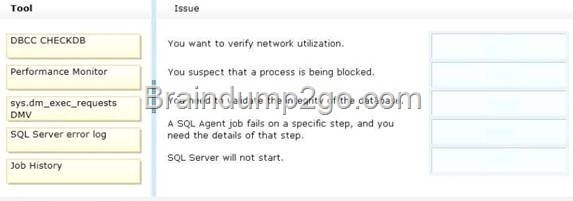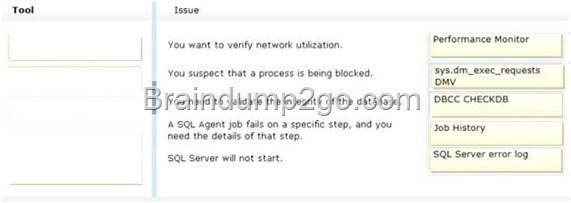QUESTION 11
You administer a Microsoft SQL Server 2012 database. You provide temporary securityadmin access to User1 to the database server. You need to know if User1 adds logins to securityadmin. Which server-level audit action group should you use?
A. SERVER_STATE_CHANGE_GROUP
B. SERVER_PRINCIPAL_IMPERSONATION_GROUP
C. SUCCESSFUL_LOGIN_GROUP
D. SERVER_ROLE_MEMBER_CHANGE_GROUP
Answer: D
Explanation:
http://technet.microsoft.com/en-us/library/cc280663.aspx
SERVER_STATE_CHANGE_GROUP
This event is raised when the SQL Server service state is modified. Equivalent to the Audit Server Starts and Stops Event Class.
SERVER_PRINCIPAL_IMPERSONATION_GROUP
This event is raised when there is an impersonation within server scope, such as EXECUTE AS <login>.
Equivalent to the Audit Server Principal Impersonation Event Class.
SUCCESSFUL_LOGIN_GROUP Indicates that a principal has successfully logged in to SQL Server. Events in this class are raised by new connections or by connections that are reused from a connection pool. Equivalent to the Audit Login Event Class.
SERVER_ROLE_MEMBER_CHANGE_GROUP
This event is raised whenever a login is added or removed from a fixed server role. This event is raised for the sp_addsrvrolemember and sp_dropsrvrolemember stored procedures. Equivalent to the Audit Add Login to Server Role Event Class.
QUESTION 12
You administer a Microsoft SQL Server 2012 instance.
You need to stop a blocking process that has an SPID of 64 without stopping other processes. What should you do?
A. Execute the following Transact-SQL statement:
EXECUTE sp_KillSPID 64
B. Restart the SQL Server service.
C. Execute the following Transact-SQL statement:
KILL 64
D. Execute the following Transact-SQL statement:
ALTER SESSION KILL ’64’
Answer: C
Explanation:
http://msdn.microsoft.com/en-us/library/ms173730.aspx
QUESTION 13
Drag and Drop Question
You administer a Microsoft SQL Server 2012 server. A variety of issues occur from time to time in the production environment. You need to identify the appropriate tool for each issue. Which tool or tools should you use? (To answer, drag the appropriate tool or tools to the correct issue or issues in the answer area. Each tool may be used once, more than once, or not at all. You may need to drag the split bar between panes or scroll to view content.)

Answer:

QUESTION 14
You administer a Microsoft SQL Server 2012 database. Users report that an application that accesses the database displays an error, but the error does not provide meaningful information. No entries are found in the SQL Server log or Windows event logs related to the error. You need to identify the root cause of the issue by retrieving the error message. What should you do?
A. Create an Extended Events session by using the sqlserver.error_reported event.
B. Create a SQL Profiler session to capture all ErrorLog and EventLog events.
C. Flag all stored procedures for recompilation by using sp_recompile.
D. Execute sp_who.
Answer: A
Explanation:
http://msdn.microsoft.com/en-us/library/bb630282.aspx
Event sqlserver.error_reported: This event gets fired every time that an error happens in the server
QUESTION 15
You administer a Microsoft SQL Server 2012 server. One of the databases on the server supports a highly active OLTP application. Users report abnormally long wait times when they submit data into the application. You need to identify which queries are taking longer than 1 second to run over an extended period of time. What should you do?
A. use SQL Profiler to trace all queries that are processing on the server.
Filter queries that have a Duration value of more than 1,000.
B. Use sp_configure to set a value for blocked process threshold.
Create an extended event session.
C. Use the Job Activity monitor to review all processes that are actively running.
Review the Job History to find out the duration of each step.
D. Run the sp_who command from a query window.
E. Run the DBCC TRACEON 1222 command from a query window and review the SQL Server event log.
Answer: E
Explanation:
Verified the SQL Profiler and DBCC answers as correct. However, while Profiler will show this information, the best practice with Profiler is to use it short-term. The question specifically states “over an extended period of time”. That means Profiler wouldn’t be the best tool for this scenario. Therefore, DBCC would be the best answer.
http://www.mssqltips.com/sqlservertip/2130/finding-sql-server-deadlocks-using-trace-flag-1222/
http://msdn.microsoft.com/en-us/library/ms188396.aspx
QUESTION 16
Drag and Drop Question
You administer a Microsoft SQL Server database that is used by an application. Users of the application report performance issues. You need to choose the appropriate tool for performance- tuning of SQL Server databases. Which tool or tools should you use? (To answer, drag the appropriate tool or tools to their corresponding task or tasks in the answer area. Each tool may be used once, more than once, or not at all. You may need to drag the split bar between panes or scroll to view content.)

Answer:

QUESTION 17
You administer a Microsoft SQL Server 2012 database. You need to ensure that the size of the transaction log file does not exceed 2 GB. What should you do?
A. Execute sp_configure ‘max log size’, 2G.
B. use the ALTER DATABASE…SET LOGFILE command along with the maxsize parameter.
C. In SQL Server Management Studio, right-click the instance and select Database Settings.
Set the maximum size of the file for the transaction log.
D. in SQL Server Management Studio, right-click the database, select Properties, and then click Files.
Open the Transaction log Autogrowth window and set the maximum size of the file.
Answer: D
QUESTION 18
You administer a Microsoft SQL Server 2012 server. The MSSQLSERVER service uses a domain account named CONTOSO\SQLService. You plan to configure Instant File Initialization. You need to ensure that Data File Autogrow operations use Instant File Initialization. What should you do? Choose all that apply.
A. Restart the SQL Server Agent Service.
B. Disable snapshot isolation.
C. Restart the SQL Server Service.
D. Add the CONTOSO\SQLService account to the Perform Volume Maintenance Tasks local security policy.
E. Add the CONTOSO\SQLService account to the Server Operators fixed server role.
F. Enable snapshot isolation.
Answer: CD
Explanation:
http://msdn.microsoft.com/en-us/library/ms175935.aspx http://www.mssqltips.com/sqlservertip/2752/effect-of-instant-file-initialization-within-sql- server/
How To Enable Instant File Initialization
1. Open Local Security Policy and go to Local Policies –> User Rights Assignment.
2. Double click Perform Volume Maintenance Tasks and add your SQL Server database engine service account.
3. Restart the SQL Server service using SQL Server Configuration Manager and this setting should now be enabled.
QUESTION 19
Drag and Drop Question
You administer a single Microsoft SQL Server instance on a two-node failover cluster that has nodes named Node A and Node B. The instance is currently running on Node A. You want to patch both Node A and Node B by using the most recent SQL Server Service Pack. You need to ensure that the following requirements are met:
Both nodes receive the update.
Downtime is minimized.
No data is lost.
Which three actions should you perform in sequence? (To answer, move the appropriate actions from the list of actions to the answer area and arrange them in the correct order.)
![clip_image00210_thumb_thumb_thumb_th[2] clip_image00210_thumb_thumb_thumb_th[2]](http://examgod.com/l2pimages/cae7cffccc32_E962/clip_image00210_thumb_thumb_thumb_th2_thumb.jpg)
Answer:
![clip_image00212_thumb_thumb_thumb_th[2] clip_image00212_thumb_thumb_thumb_th[2]](http://examgod.com/l2pimages/cae7cffccc32_E962/clip_image00212_thumb_thumb_thumb_th2_thumb.jpg)
QUESTION 20
You administer a Microsoft SQL Server 2012 failover cluster that contains two nodes named Node A and Node B. A single instance of SQL Server is installed on the cluster. An additional node named Node C has been added to the existing cluster. You need to ensure that the SQL Server instance can use all nodes of the cluster. What should you do?
A. Run the New SQL Server stand-alone installation Wizard on Node C.
B. Run the Add Node to SQL Server Failover Cluster Wizard on Node C.
C. Use Node B to install SQL Server on Node C.
D. Use Node A to install SQL Server on Node C.
Answer: B
Explanation:
http://technet.microsoft.com/en-us/library/ms191545.aspx To add a node to an existing SQL Server failover cluster, you must run SQL Server Setup on the node that is to be added to the SQL Server failover cluster instance. Do not run Setup on the active node.
The Installation Wizard will launch the SQL Server Installation Center. To add a node to an existing failover cluster instance, click Installation in the left-hand pane. Then, select Add node to a SQL Server failover cluster.
Braindump2go New Updated Microsoft 70-462 Exam Questions and Answers Free Download: http://www.braindump2go.com/70-462.html